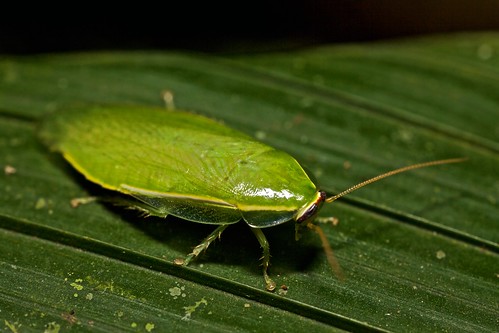Here is a link to the comic
I love Wondermark. There are a number of highly amusing science comics by Malki that rank among the best comics I've ever LOL'ed at. This is no exception. Here, encapsulated in a simple webcomic, is all that I have wondered about human and animal 'language.' We consider ourselves sophisticated users of language because we have things like arbitrary signs (like beeping for instance), ability to talk about displaced or non-existent objects, and infinite flexibility of expression. However, these very things that we consider to make our communication of a higher order than the rest of the world, also makes our communication more obfuscated. A wolf's growl communicates in perfect clarity and simplicity across multiple species. No one needs to learn what it means, and no one needs any more information than it provides.
Thursday, April 7, 2011
Thursday, March 24, 2011
Wetas
Above and Beyond in the Down Under: Cool Creepy Crawlies.
The snow today reminds me of the alpine weta, a creature that can survive being frozen solid. May we all weather our trials with the same cool-headed-ness.
The snow today reminds me of the alpine weta, a creature that can survive being frozen solid. May we all weather our trials with the same cool-headed-ness.
Saturday, March 19, 2011
Plants (who knew?)
 You may be surprised to find that now we're going to talk about the communication systems of plants. Turns out plants can be pretty smart for creatures without brains, nerves, muscles, or specialized sensory organs. When evil herbivores like caterpillars start to munch on plants, plants do not have the option of running away. Instead plants stand their ground with a full arsenal of defenses. Many of these defenses have a direct affect on the herbivore. Direct defenses are things like antifeedants which deter caterpillar feeding, toughening agents that make the plant tissue hard to digest, hairs called trichomes that make the plant tissue spikey and can secrete noxious chemicals, proteinase inhibitors which stymie digestive enzymes in the insect gut, and caterpillar poisons which can kill 'em dead. Direct defenses are the bread-and-butter of plants under herbivore attack. There is another kind of defense, however, called indirect defenses - a way to "call in the cavalry" so to speak.
You may be surprised to find that now we're going to talk about the communication systems of plants. Turns out plants can be pretty smart for creatures without brains, nerves, muscles, or specialized sensory organs. When evil herbivores like caterpillars start to munch on plants, plants do not have the option of running away. Instead plants stand their ground with a full arsenal of defenses. Many of these defenses have a direct affect on the herbivore. Direct defenses are things like antifeedants which deter caterpillar feeding, toughening agents that make the plant tissue hard to digest, hairs called trichomes that make the plant tissue spikey and can secrete noxious chemicals, proteinase inhibitors which stymie digestive enzymes in the insect gut, and caterpillar poisons which can kill 'em dead. Direct defenses are the bread-and-butter of plants under herbivore attack. There is another kind of defense, however, called indirect defenses - a way to "call in the cavalry" so to speak.  Most every insect has an arch-enemy - a parasitoid. Caterpillar parasitoids are usually tiny wasps. When a parasitoid wasp finds its host caterpillar, it will lay its egg(s) in the caterpillar. The parasitoid wasp's eggs develop inside the caterpillar and will eventually, Alien-like, pop out of the caterpillar to pupate and complete their development into adult wasps. This is a pretty painful process for the caterpillar, which is essentially converted into a wasp-incubator and then dies.
Most every insect has an arch-enemy - a parasitoid. Caterpillar parasitoids are usually tiny wasps. When a parasitoid wasp finds its host caterpillar, it will lay its egg(s) in the caterpillar. The parasitoid wasp's eggs develop inside the caterpillar and will eventually, Alien-like, pop out of the caterpillar to pupate and complete their development into adult wasps. This is a pretty painful process for the caterpillar, which is essentially converted into a wasp-incubator and then dies.  You may be wondering how a little wasp finds the right caterpillar. It's a bit like looking for a needle in a haystack, right? If only the haystack would tell you where the needle is hidden! Well, that's essentially what plants do when they activate their indirect defenses. In response to specific compounds called elicitors in the caterpillar's spit, the plant will launch a beacon consisting of a unique blend of odors (usually a blend of terpenes). Parasitoid wasps are attracted to these odors, and come flying to aid the plant by parasitizing the caterpillars trying to catch a meal off the plant. The smell of the beacon is only activated by the caterpillar's spit, and is unique for each species of caterpillar, providing a reliable signal for the parasitoid wasps to find their specific host. The plant-insect communication system really works because the parasitoid wasps are very sensitive to odors and very good at associative learning. They can associate just about any odor or complex odor blend with the stimulus of laying an egg in a caterpillar. Once they've had the experience of finding caterpillar hosts on a plant that smells just so, they will continue to seek out that smell to find more caterpillars. It's a win-win - well, at least for the plant and the wasp.
You may be wondering how a little wasp finds the right caterpillar. It's a bit like looking for a needle in a haystack, right? If only the haystack would tell you where the needle is hidden! Well, that's essentially what plants do when they activate their indirect defenses. In response to specific compounds called elicitors in the caterpillar's spit, the plant will launch a beacon consisting of a unique blend of odors (usually a blend of terpenes). Parasitoid wasps are attracted to these odors, and come flying to aid the plant by parasitizing the caterpillars trying to catch a meal off the plant. The smell of the beacon is only activated by the caterpillar's spit, and is unique for each species of caterpillar, providing a reliable signal for the parasitoid wasps to find their specific host. The plant-insect communication system really works because the parasitoid wasps are very sensitive to odors and very good at associative learning. They can associate just about any odor or complex odor blend with the stimulus of laying an egg in a caterpillar. Once they've had the experience of finding caterpillar hosts on a plant that smells just so, they will continue to seek out that smell to find more caterpillars. It's a win-win - well, at least for the plant and the wasp.So we have a great example of cross-kingdom communication. Why don't plants talk to each other? If you were a tomato plant like one in my garden, crowded up against your neighbors, you couldn't help but 'overhear' when one of your neighbors gets attacked by an herbivore by sensing the parasitoid-calling odor beacon and other compounds that are released when a leaf is damaged. And if your neighbor is being munched, odds are good that you might get munched soon too. Probably should go ahead and load your guns. This is the theory behind priming - that the perception of herbivores feeding on neighboring plants allows undamaged plants to be primed to mount a faster, stronger defense response when the herbivores eventually come for them too. Interestingly, the existence and importance of priming in various plant systems is still in question. For one, plants aren't real cooperative or social creatures, so we don't really expect them to be selected to lend a hand to their neighbors. Also, it is not necessary to assume that just because you can smell the smell of a damaged plant you will certainly be next on the herbivore hit-list. In addition, some have scoffed at the idea of priming just because plants don't typically come equipped with noses with which to sense odors from neighboring plants. Though, is communication dependent on having a mouth and tongue to make words or ears to hear them?
Ichneumonid parasitoid wasp image by Tony Wills [http://www.gnu.org/copyleft/fdl.html], CC-BY-2.5
Thursday, March 17, 2011
Lighting Bugs: The Flash and the Furious
Nothing quite expresses the sublime joy of watching fireflies paint the night sky with their glowing tails. Few realize, however, that their beautiful language is for the purpose of mating. Male fireflies take off just after dark, emitting a telegraphic pattern of flashes that can vary in intensity, shape, length, and periodicity. Each species has a unique flash pattern which the female recognizes among all the other flashes as the one belonging to her species. In between pattern repeats, the male waits for the female to respond with her own characteristic flash from her hiding spot in the vegetation. When he catches sight of her come-hither flash, the male circles back, repeating his flash pattern and waiting for her to repeat her response. This way the male and the female firefly call to each other in the dark until they locate each other and consummate their romantic conversation.
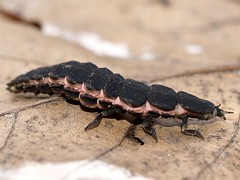 Fireflies are beetles belonging to the family Lampyridae. They spend most of their lives as larvae (glow-worms), living in dark and muddy places and preying on snails. Like moths, their adult lives are short. Like moths, many beetles related to fireflies will use sex pheromones rather than light to attract their mates. The unique bioluminescence of fireflies, however, allows them to wait until dark (when birds and other predators are asleep) to come out to mate. Specific flash patterns make the species immediately identifiable from a long distance at night. The frequency and intensity of light flashes can also communicate information about the male's quality as a mate. These advantageous aspects to light communication has led to the evolution of light-based sexual signals four times in the firefly lineage.
Fireflies are beetles belonging to the family Lampyridae. They spend most of their lives as larvae (glow-worms), living in dark and muddy places and preying on snails. Like moths, their adult lives are short. Like moths, many beetles related to fireflies will use sex pheromones rather than light to attract their mates. The unique bioluminescence of fireflies, however, allows them to wait until dark (when birds and other predators are asleep) to come out to mate. Specific flash patterns make the species immediately identifiable from a long distance at night. The frequency and intensity of light flashes can also communicate information about the male's quality as a mate. These advantageous aspects to light communication has led to the evolution of light-based sexual signals four times in the firefly lineage. The flash dance of fireflies can be exploited, however. If you're skilled with a small pen-light you can trick male fireflies to land on your hand by flashing back at them as a female firefly would. Females of the genus Photuris have also learned to pull this prank on male fireflies. Photuris females will call to males of other firefly species, but not for mating. These femmes fatales are looking for a snack. The male, oblivious to the fact that the female below is not of his own species, flies straight into her welcoming jaws.
Figure of firefly flash patterns by J. E. Lloyd, University of Florida from Fireflier Companion (1998) 1(4): 56.
Image of Photuris female munching on male also by J. E. Lloyd.
Tuesday, March 15, 2011
Moth Madness
 Adult moths live much like many college students in that their lives revolve around sex. During their very short existence, their only imperative is to reproduce. To this end, they have a streamlined chemical communication system. The female moth produces a unique chemical compound which is known as the sex pheromone. This arousing perfume is produced in glands in her rear end in extremely minute quantities (picograms (10-12 grams) per hour). The male's antennae are attuned to this odor and can sense her pheromone from afar. Like a bloodhound, he homes in on the female. Actually, the male locates the female by following her scent upwind. No need to even be able to follow a concentration gradient or make interesting small-talk. It's dead simple.
Adult moths live much like many college students in that their lives revolve around sex. During their very short existence, their only imperative is to reproduce. To this end, they have a streamlined chemical communication system. The female moth produces a unique chemical compound which is known as the sex pheromone. This arousing perfume is produced in glands in her rear end in extremely minute quantities (picograms (10-12 grams) per hour). The male's antennae are attuned to this odor and can sense her pheromone from afar. Like a bloodhound, he homes in on the female. Actually, the male locates the female by following her scent upwind. No need to even be able to follow a concentration gradient or make interesting small-talk. It's dead simple.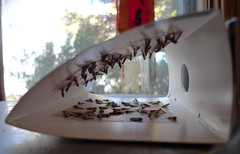 Once male finds female, close-range signals such as compounds present on their cuticles can tell the moths something about each other and their qualities as a mate. When you don't live long, though, it doesn't pay to be picky. The response of male moths to sex pheromones is so predictable, sex pheromones are a great way to control pest moth species without pesticides. A trap like the one in this picture uses an artificial lure imbued with sex pheromone. Males are attracted to the trap, but instead of finding a lovely lady, they find a surface covered in killer sticky slime.
Once male finds female, close-range signals such as compounds present on their cuticles can tell the moths something about each other and their qualities as a mate. When you don't live long, though, it doesn't pay to be picky. The response of male moths to sex pheromones is so predictable, sex pheromones are a great way to control pest moth species without pesticides. A trap like the one in this picture uses an artificial lure imbued with sex pheromone. Males are attracted to the trap, but instead of finding a lovely lady, they find a surface covered in killer sticky slime. Another way of controlling moths with sex pheromones is a method known as mating disruption. The sex pheromone is often loaded into little plastic tubes like this one that can be hung from trees. Sex pheromone produced by the real moths will be mixed with synthetic pheromone being produced by scads of tiny plastic tubes. Flooding the whole area with sex pheromone makes it very hard for males to locate females. Even when they do manage to find the odor source, a bit of plastic is a poor reward for following a odor plume.
The simple sex pheromone communication system of moths does not constitute a language. But while simple, it is extremely effective, providing a reliable, low concentration, long-range signal requiring minimal energy investment for either the sender to produce or for the receiver to interpret. Moths need no online dating service with its 29 dimensions of compatibility. They already have a language tailor-made for fast and easy hookups.
Pheromone dispenser photo by Eugene E. Nelson, Bugwood.org, used under a Creative Commons License.
Sunday, March 13, 2011
Honeybees - starting at the end
When starting a lecture on animal communication, most people would probably leave the honeybees for last. Only because their communication has some unique linguistic features most other animal communication lacks. Namely: symbols. Honeybees have an elaborate language for communicating the location of food and shelter through dance. We have decoded most of it due to the Nobel Prize-winning work of an Austrian named Karl von Frisch.
 (Herr Dr. von Frisch looks great in lederhosen, don't you think?).
(Herr Dr. von Frisch looks great in lederhosen, don't you think?).
Karl von Frisch discovered that European honeybees (Apis mellifera) could communicate the precise location of a resource by dancing.
(Can you imagine anything more wonderful? What if we communicated through dance alone? Tell me that doesn't sound like fun.)
The dance has two components: an angle and a distance - all the bees need to find a location. The angle is communicated by the angle at which the bee takes a waggle run relative to straight up. Outside, this angle corresponds to the angle of the resource relative to the sun. The length of time the dancing bee spends waggling corresponds to the distance to the food resource. When a forager bee comes back from collecting food, she will dance, and in the dark hive, other bees will surround her and follow her dancing movements repeatedly, extracting the location information from her movements. Then the foragers will set out to the location she indicated. This is the basic formula for the dance language. Other aspects, such as sharing nectar samples, floral odors, and vibrational signals also play a role in telling the other bees the type and quality of the food resource.
The dance language is also used when a swarm (a newly budded bee community ready to start their own hive) needs to find a hollow cavity to nest in. Scouts that find a suitable cavity dance to communicate its location to the other workers. The better the cavity, the longer a bee will dance for it. This length of time spent dancing is key to the collective decision-making of the swarm, which must take off all at once and move together if they are to survive. The longer a bee dances for a location, the more recruits she will get to check out the possible new home, and the more bees will come back to dance for that location. Eventually, almost all the scouts will be dancing for the preferred location. Once they have reached a quorum, the bees take off to colonize the new home.
So that's the fantastic story of the honeybee dance language. My question is: why so sophisticated? Why do honeybees alone among invertebrates demonstrate use of symbols? Why are honeybees considered the pinnacle of insect communication? Honeybees themselves are not very remarkable insects. Physiologically, they are similar to their bumblebee and wasp brethren in brain capacity. One thing that they do have that many other bees and wasps lack, however, is eusociality.
Eusociality is the term we use to describe social animals where there is:
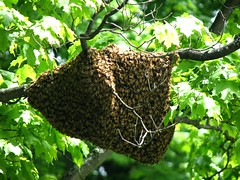 Only a handful of animal species fit this definition. In many ways, honeybees wrote this definition. A single queen bee lays all the eggs in the hive, while the workers (sisters and offspring of the same queen) do all the work of gathering food, feeding the young, constructing, maintaining, and guarding the nest. The honeybee hive functions as a super-organism, with each individual doing its part to serve the hive. The critical phase in the reproduction of this super-organism is the swarming stage, when the hive buds, and a group of bees and a queen must choose a new nest. For the European honeybee, which requires a suitable cavity, this selection process is very important to deciding the future fate of the swarm. You could imagine that the selective pressure would be extremely high for an efficient way of communicating the location of a possible new nest site.
Only a handful of animal species fit this definition. In many ways, honeybees wrote this definition. A single queen bee lays all the eggs in the hive, while the workers (sisters and offspring of the same queen) do all the work of gathering food, feeding the young, constructing, maintaining, and guarding the nest. The honeybee hive functions as a super-organism, with each individual doing its part to serve the hive. The critical phase in the reproduction of this super-organism is the swarming stage, when the hive buds, and a group of bees and a queen must choose a new nest. For the European honeybee, which requires a suitable cavity, this selection process is very important to deciding the future fate of the swarm. You could imagine that the selective pressure would be extremely high for an efficient way of communicating the location of a possible new nest site.
This is only one theory that might explain the evolution of such complex behavior in honeybees rather than other species which do not exhibit swarm-founding. Indeed, the selective pressure for more advanced communication must increase with increasing levels of cooperative behavior. Is this true? Do we find other examples in the animal kingdom of advanced communication in conjunction with cooperative behavior?
 (Herr Dr. von Frisch looks great in lederhosen, don't you think?).
(Herr Dr. von Frisch looks great in lederhosen, don't you think?). Karl von Frisch discovered that European honeybees (Apis mellifera) could communicate the precise location of a resource by dancing.
(Can you imagine anything more wonderful? What if we communicated through dance alone? Tell me that doesn't sound like fun.)
The dance has two components: an angle and a distance - all the bees need to find a location. The angle is communicated by the angle at which the bee takes a waggle run relative to straight up. Outside, this angle corresponds to the angle of the resource relative to the sun. The length of time the dancing bee spends waggling corresponds to the distance to the food resource. When a forager bee comes back from collecting food, she will dance, and in the dark hive, other bees will surround her and follow her dancing movements repeatedly, extracting the location information from her movements. Then the foragers will set out to the location she indicated. This is the basic formula for the dance language. Other aspects, such as sharing nectar samples, floral odors, and vibrational signals also play a role in telling the other bees the type and quality of the food resource.
The dance language is also used when a swarm (a newly budded bee community ready to start their own hive) needs to find a hollow cavity to nest in. Scouts that find a suitable cavity dance to communicate its location to the other workers. The better the cavity, the longer a bee will dance for it. This length of time spent dancing is key to the collective decision-making of the swarm, which must take off all at once and move together if they are to survive. The longer a bee dances for a location, the more recruits she will get to check out the possible new home, and the more bees will come back to dance for that location. Eventually, almost all the scouts will be dancing for the preferred location. Once they have reached a quorum, the bees take off to colonize the new home.
So that's the fantastic story of the honeybee dance language. My question is: why so sophisticated? Why do honeybees alone among invertebrates demonstrate use of symbols? Why are honeybees considered the pinnacle of insect communication? Honeybees themselves are not very remarkable insects. Physiologically, they are similar to their bumblebee and wasp brethren in brain capacity. One thing that they do have that many other bees and wasps lack, however, is eusociality.
Eusociality is the term we use to describe social animals where there is:
- Reproductive division of labor - some individuals reproduce while others give up or delay their own reproduction
- Overlapping generations - individuals from previous generations live together with individuals from the current generation
- Cooperative care of young - non-reproductive individuals rear other individuals' offspring
 Only a handful of animal species fit this definition. In many ways, honeybees wrote this definition. A single queen bee lays all the eggs in the hive, while the workers (sisters and offspring of the same queen) do all the work of gathering food, feeding the young, constructing, maintaining, and guarding the nest. The honeybee hive functions as a super-organism, with each individual doing its part to serve the hive. The critical phase in the reproduction of this super-organism is the swarming stage, when the hive buds, and a group of bees and a queen must choose a new nest. For the European honeybee, which requires a suitable cavity, this selection process is very important to deciding the future fate of the swarm. You could imagine that the selective pressure would be extremely high for an efficient way of communicating the location of a possible new nest site.
Only a handful of animal species fit this definition. In many ways, honeybees wrote this definition. A single queen bee lays all the eggs in the hive, while the workers (sisters and offspring of the same queen) do all the work of gathering food, feeding the young, constructing, maintaining, and guarding the nest. The honeybee hive functions as a super-organism, with each individual doing its part to serve the hive. The critical phase in the reproduction of this super-organism is the swarming stage, when the hive buds, and a group of bees and a queen must choose a new nest. For the European honeybee, which requires a suitable cavity, this selection process is very important to deciding the future fate of the swarm. You could imagine that the selective pressure would be extremely high for an efficient way of communicating the location of a possible new nest site.This is only one theory that might explain the evolution of such complex behavior in honeybees rather than other species which do not exhibit swarm-founding. Indeed, the selective pressure for more advanced communication must increase with increasing levels of cooperative behavior. Is this true? Do we find other examples in the animal kingdom of advanced communication in conjunction with cooperative behavior?
Saturday, March 12, 2011
Animal Linguistics Series
My linguist friend has invited me (ok maybe I volunteered) to give a guest lecture to her class. In this lecture, I will cover a number of examples of animal communication and compare and contrast these communication systems with those of humans.
Linguistics has always seemed very interesting to me. I might even classify myself as a word geek. I collect new words like shiny insects, pinning them down by using them often. I am very good at crosswords.
Communication in the animal and particular the insect world, however, is rarely possessed of such nuance as actual words. Nevertheless, animals say a whole lot with chemical, sound, and visual signals. Some animal communication systems are surprisingly complex.
To prepare for this lecture, I'm going to go through a few outstanding examples of animal communication over the next several days. Enjoy!
Linguistics has always seemed very interesting to me. I might even classify myself as a word geek. I collect new words like shiny insects, pinning them down by using them often. I am very good at crosswords.
Communication in the animal and particular the insect world, however, is rarely possessed of such nuance as actual words. Nevertheless, animals say a whole lot with chemical, sound, and visual signals. Some animal communication systems are surprisingly complex.
To prepare for this lecture, I'm going to go through a few outstanding examples of animal communication over the next several days. Enjoy!
Monday, January 3, 2011
What is a cockroach?
This is a cockroach, order Blattodea. Insects in the order Blattodea (or Blattaria if you're old-school - either way it's a roach) are characterized by long, slender cursorial (running) legs with which they achieve impressive speeds. The top of their first thoracic segment (aka the pronotum) extends up to cover their heads as a shield-shaped hat. Their mouths contain a pair of plain, sensible mandibles for chewing, their 30+ segmented antennae are thin and sensitive, ranging far ahead of their body to warn of impending danger as they run. In those cockroaches that have wings, the first pair is thickened, leathery (they're called tegmina), protecting the hind pair that is thin and membranous.
Many cockroaches are earth-toned: dull brown, tan, red, and black. A few, like the beautiful cuban cockroach (Panchlora nivea) pictured above, have striking coloration.
One thing a cockroach is not, however, is fancy. You will never find them trying to stand out with flashy patterns. They are meant to blend in with the background. Flat bodies, shielded heads, leathery forewings, the body of a cockroach is made for sneaking into small hiding places and for furtive avoidance of malicious predators. Their beauty is a functional one.
Labels:
antennae,
beauty,
blattaria,
cockroaches,
coloration,
form,
function,
insect legs
Sunday, January 2, 2011
Confessions of a Cockroach lover
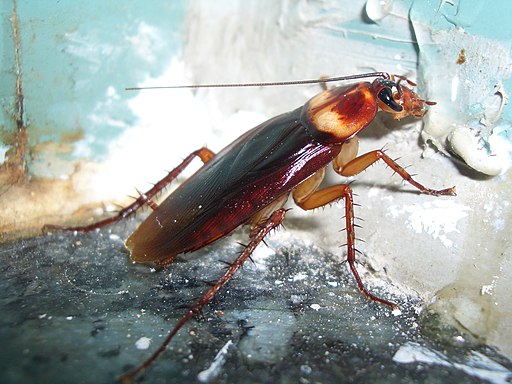
MMMHHhh tasty water!
I have a confession to make. I am not afraid of cockroaches. I know, I should be. They carry diseases, they cause allergies, they're icky and run too fast. All of which, in any normal human being, should be cause for alarm.
But I just can't do it.
Why? Because they're just doing their jobs - fulfilling their cockroachy calling. Allow me to explain.
Living things are messy. It's true. We secrete and excrete and shed everywhere. When we eat, we always leave crumbs and sticky smears behind. Then we go and die and leave our messy bodies behind. Someone has to pick up the trash. A lot of times, that someone is an insect. Dung beetles specialize on picking up our crap. Ants will happily take our crumbs and lick up our sticky residues. Flies specialize on cleaning up our dead flesh after we've left this world. Cockroaches aren't really specialists. They are the garbage-men. You put it out, they pick it up.
We humans have taken messy up to a whole another level. We have made certain choices to live certain ways that create a lot of garbage. This garbage is typically a mixture of components, bits of organic matter hidden in pockets of inorganic containers and structures. The inorganic stuff is pretty useless to the rest of the living world (not entirely useless, but requiring a great deal of time and energy to return to a useful state) but the organic stuff someone can always use for food. But then who's going to go and extract it? What garbage-man would come into your house and take away all your crumbs from under the fridge? Lick our your yogurt containers, scarf up the stale cookies in your pantry, and clean the slime that clings to the inside of the drainplug in your tub? Cockroaches, that's who. They're the most effective garbage-men ever.
Their all-encompassing garbage-picking skills is what makes cockroaches susceptible to contamination by various nasty microbes. These valiant trash-men don't mind exploring your toilet brush and then your kitchen counters for delicious morsels. 'Clean dish' and 'dirty dish' is not a distinction that they know how to make. So the problem with cockroaches isn't so much the roaches themselves, but the microbes they accidentally pick up when they're on clean-up duty.
Funny thing about those microbes, though- they were already hanging around. In most cases, they were as close as your bathroom floor and your sink. The cockroaches just moved them around. Cross contamination: it's the worst kind of cooties.
So how do you keep the cockroach garbage-men on the curb? Keep your trash there too. Clean up after yourself, and the cockroaches won't have to come and do it for you.
Labels:
blattaria,
cockroaches,
disease,
entomophilia,
entomophobia,
garbage-men,
prejudice,
waste
Subscribe to:
Posts (Atom)







